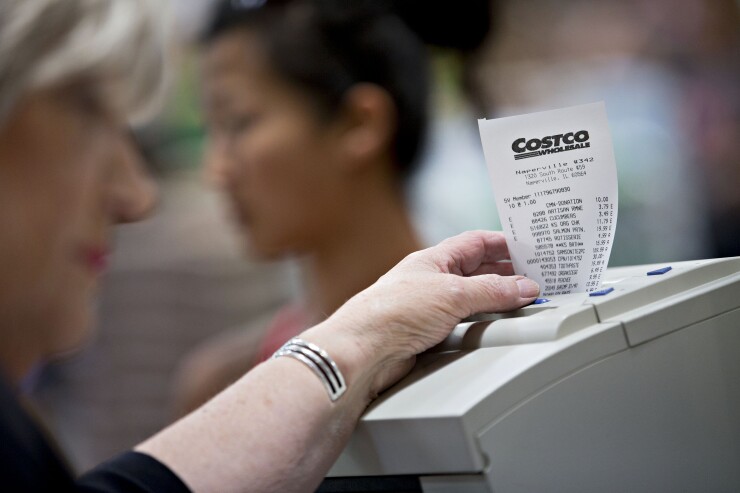One of the ways U.S. card issuers tried to minimize challenges of migrating to EMV was by taking the simplest possible approach to the chip upgrade with contact-only cards that lacked Near Field Communication and required no PIN for credit card verification.
Perhaps that decision was too hasty.
Issuers are watching the consumer response to Citi’s rollout of its cobranded Costco card, which is the largest U.S. portfolio of EMV cards that are also NFC-enabled.
The use case extends far beyond Costco's walls; more than 70% of the use of Costco-branded Citi Anywhere Visa cards occurred outside of the warehouse giant's stores, Citi said last month when announcing third-quarter earnings.

Citi didn’t disclose which merchants are seeing the bulk of transactions with its new card or whether consumers are swiping or tapping the cards at the checkout. But experts say adding NFC to cards often increases card spending by diverting smaller-ticket purchases at pharmacies, convenience and fast-food stores away from cash—an advantage other U.S. issuers should envy.
It's not certain whether Citi will reap big results by being the first to add NFC to a large EMV card portfolio in the U.S.
Issuers and merchants so far have had disappointing results with contactless payment cards, which flopped in pilots several years ago. The much-hyped NFC-based mobile wallet Apple Pay continues to languish without broad adoption more than two years after its rollout, similar to Android Pay and Samsung Pay.
But Citi is trying a different tack this time by introducing NFC-enabled cards on a big scale at a time when major merchants in prime categories for tap-and-go payments—including McDonald’s, Walgreens and CVS—finally support contactless payments, said Bastian Knoppers, a senior vice president at FIS.
“NFC hasn’t caught on before in the U.S. because the use case wasn’t very clear to consumers,” Knoppers said. “Suddenly we have millions of consumers holding the Costco NFC cards, a much thicker base of NFC-supporting merchants, and with people trying to get through checkout lines faster, paying with a contactless card is going to begin to make more sense to them.”
That’s what happened in Canada, Australia and the
“Citi’s adoption of dual-interface credit cards is monumental in its potential effect on NFC use in the U.S., given the size and scale of the portfolio,” said Jack Jania, senior vice president of strategic alliances at Gemalto, a leading global card manufacturer. “We’re seeing more and more interest from issuers who are looking at adding NFC to their cards—they’re watching closely to see what kind of results Citi gets in upcoming quarters.”
Ironically, Costco itself has not yet enabled EMV or NFC at its own payment terminals. The company declined to say when—or whether—it will go live with NFC so its own members can tap to pay at checkout, but Jania speculates it’s on the company's road map.
Many merchants are in the same boat as Costco, still struggling to upgrade older payment terminals to EMV months after the Oct. 1, 2015 liability shift, often caught in service and vendor bottlenecks waiting for technical assistance and certifications from networks, acquirers and processors.
Some merchants, worried about how EMV may
“In supermarket checkout lanes, people may be used to pre-swiping their card while their order is rung up, but they can’t do that with contactless EMV or (contact) EMV chip cards, so either type of chip-card transaction would be slower (than swiping),” said Randy Vanderhoof, executive director of the U.S. Payments Forum.
However, Vanderhoof confirmed that where payment terminals are enabled for both EMV contact and contactless cards, NFC-enabled card transactions likely will go through “a few seconds faster.” Unlike a regular contact-chip payment, the terminal doesn’t require an authorization message, Vanderhoof explained.
But in a scenario where all cards and merchant terminals are NFC-enabled, which is the case in many countries today, there is no question that contactless EMV card transactions are speedier than contact-only cards, Vanderhoof said.
"Citi is ahead of the curve as an issuer and Costco has not turned on EMV, yet so it is still a little early for this to be the bellwether, but we know that more issuers are looking at dual interface for their second generation EMV cards," Vanderhoof said.
Citi inherited 11 million new accounts from former owner





